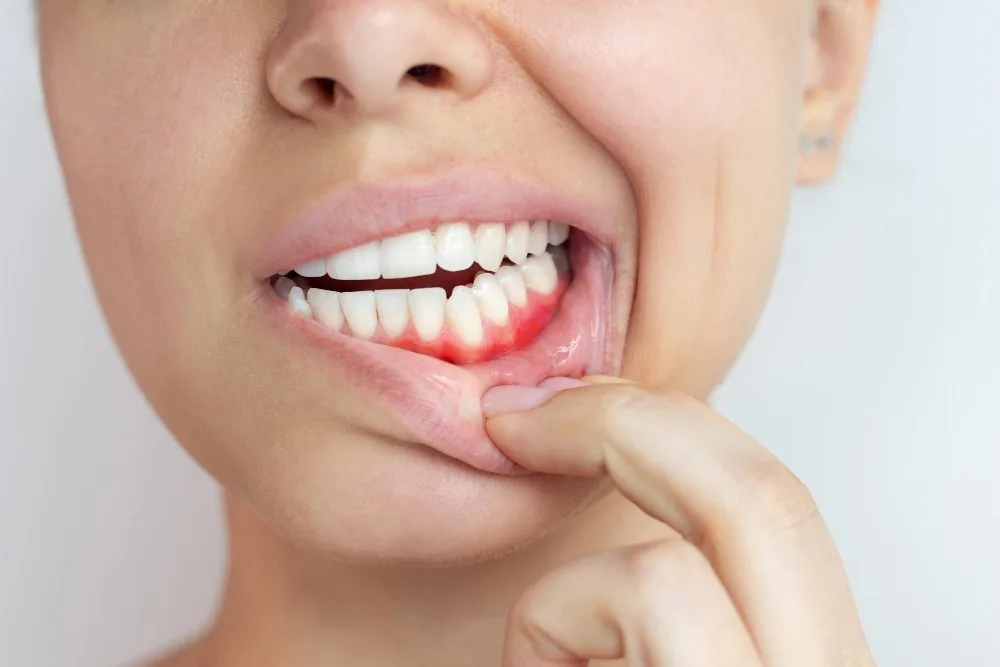Gum Cyst: A Common Overlooked Condition
A gum cyst is a fluid-filled or semi-solid sac that develops on the gum tissue, often near a tooth or along the inside of the cheeks or lips. Though usually benign, it can cause discomfort, swelling, and aesthetic concerns. Some gum cysts remain small and painless, while others enlarge and interfere with speaking, chewing, or even tooth alignment if left untreated.
These cysts may arise for several reasons, including trauma to the gums, blocked salivary glands, or developmental anomalies. They can occur in both children and adults, and often present as soft, translucent, or bluish bumps. Depending on the type and location, treatment options vary from simple observation to surgical excision.
Understanding what a gum cyst is—and recognizing the early signs—can help prevent complications and guide patients toward effective treatment. This series of articles outlines everything you need to know about gum cysts, from causes and diagnosis to treatment and prevention.
Gum Cyst: What It Is and Where It Occurs
A gum cyst is a small, sac-like lesion that forms within or on the gum tissue. It may contain fluid, pus, or other material and can vary in size and texture. These cysts are not tumors but rather encapsulated growths often resulting from blocked ducts, injury, or infection.
Most gum cysts occur near the surface of the gums but can also form deeper, especially around the roots of teeth. They are typically round or oval and may appear whitish, pink, or translucent. Some are painless and discovered during routine dental exams, while others may become tender or swollen, prompting a visit to the dentist.
Gum cysts are most frequently found near impacted teeth, erupting wisdom teeth, or areas of previous dental work. In children, they can appear during tooth eruption and usually resolve on their own. In adults, however, cysts are more likely to require intervention.
Although a gum cyst may seem minor, it should never be ignored. Even benign lesions can lead to secondary infections, gum recession, or bone loss if untreated. Prompt evaluation by a dental professional ensures that the nature of the cyst is understood and that appropriate care is provided.
Gum Cyst Causes: Trauma, Blocked Glands, and Developmental Issues
A gum cyst can form for several reasons, and identifying the root cause is key to effective treatment. One common cause is physical trauma—such as biting the cheek or lip repeatedly, brushing too aggressively, or damage from orthodontic appliances. Such injuries may trigger the development of mucoceles, which are mucus-filled cysts caused by blocked salivary glands.
Blocked ducts are another frequent contributor. When salivary flow is obstructed due to inflammation, scar tissue, or a small stone (sialolith), the gland may swell and form a cyst beneath the mucosal surface. This is often seen on the inner cheeks, lips, or floor of the mouth but can also involve the gumline.
Developmental anomalies are less common but equally important. During tooth formation or jaw growth, remnants of epithelial tissue may be left behind. These remnants can later proliferate and form cysts, such as gingival cysts in newborns or lateral periodontal cysts in adults.
Occasionally, cysts may be linked to chronic inflammation, poor oral hygiene, or an untreated infection in a nearby tooth. In such cases, addressing the underlying infection is crucial to preventing recurrence.
Understanding what caused the gum cyst helps guide treatment decisions, from watchful waiting to surgical removal or additional dental procedures. A thorough clinical exam and imaging can determine whether the cyst is benign or associated with a more complex issue.
Types of Gum Cyst: Mucocele, Epulis, Gingival, Lateral Periodontal
Several types of gum cysts can form, each with distinct features, causes, and preferred treatments. The most common type is a mucocele, which forms when a salivary gland duct is damaged or blocked. Mucoceles typically appear on the inside of the lips or cheeks, but may extend to the gumline and are usually soft and translucent.
Epulis is another category of gum growth often mistaken for a cyst. It’s actually a reactive lesion—often resulting from irritation, pregnancy, or poorly fitting dentures—and appears as a firm, gum-colored bump near the teeth. While not true cysts, epulides are treated similarly through removal and cause elimination.
Gingival cysts are benign lesions found on the gum surface, typically in the front lower jaw of adults. They are small, painless, and may be picked up during a routine exam. In infants, similar cysts may appear on the alveolar ridge and are known as dental lamina cysts or eruption cysts.
Lateral periodontal cysts occur deeper in the jaw, near the roots of vital teeth, often between the premolars. These are usually asymptomatic and identified via dental X-rays. Their management typically involves surgical enucleation.
Recognizing the type of gum cyst helps determine whether immediate treatment is necessary or if monitoring is sufficient. Accurate classification also ensures that potentially serious conditions, like tumors or abscesses, are not overlooked.
Symptoms of a Gum Cyst: When to Seek Dental Evaluation
The symptoms of a gum cyst can vary based on its type, size, and location. While some remain unnoticed for weeks or months, others can cause irritation, swelling, or interfere with chewing and speaking.
One of the most common signs is a small, round bump on the gum tissue. It may feel soft or firm and can range in color from pale pink to bluish or translucent. Some gum cysts are painless, while others cause localized discomfort, especially when pressed or irritated during brushing or eating.
Other possible symptoms include bleeding, inflammation, or a sensation of fullness in the gum or cheek. If the cyst becomes infected, it may release pus, produce a foul taste, or be accompanied by fever and swelling.
In certain cases, a gum cyst can cause tooth movement or pressure, particularly if it grows near the root of a tooth or along the gumline. Deep cysts may cause bone erosion if left untreated for an extended period.
You should seek dental evaluation if you notice any unexplained bumps, swelling, or changes in your gum tissue that persist for more than a few days. Early diagnosis can prevent complications and ensure that the most effective treatment plan is established.
Home Remedies for a Gum Cyst: When Observation Is Acceptable
In some cases, a gum cyst may resolve on its own or remain stable without intervention. This is particularly true for small mucoceles or gingival cysts in infants, which often disappear as the mouth develops or heals from minor trauma.
When a gum cyst is painless, doesn’t interfere with eating or speaking, and isn’t growing, dentists may recommend a “watch and wait” approach. During this time, patients are advised to avoid irritating the area and to maintain good oral hygiene.
Rinsing the mouth gently with warm salt water can help reduce inflammation and prevent bacterial buildup around the cyst. Using a soft toothbrush and avoiding spicy or acidic foods can also minimize discomfort and reduce the chance of aggravating the lesion.
Natural remedies like aloe vera gel or clove oil are sometimes used to soothe minor gum irritation, though they don’t remove the cyst itself. These should only be applied externally or as mouth rinses—never directly into an open or ulcerated lesion.
It’s important not to attempt draining or popping a gum cyst at home, as this can lead to infection, delayed healing, or further trauma. Instead, monitor the lesion closely and contact your dentist if the cyst grows, becomes painful, or starts to affect nearby teeth.
Observation may be appropriate for certain types of gum cysts, but only under the guidance of a dental professional who has ruled out more serious conditions.
Surgical Removal of Gum Cyst: What Patients Should Expect

If a gum cyst is persistent, growing, painful, or interfering with oral function, surgical removal may be the most effective option. The procedure is typically straightforward and performed under local anesthesia in a dental or oral surgery clinic.
During the procedure, the dentist or oral surgeon carefully excises the cyst along with a small margin of surrounding tissue to ensure complete removal. This is particularly important for cysts with a fibrous capsule, as partial removal increases the risk of recurrence.
Depending on the cyst’s location and depth, the wound may be left to heal naturally or closed with sutures. The entire process usually takes less than an hour, and patients can return home the same day.
Postoperative care includes gentle rinsing with a saltwater solution, avoiding hard or spicy foods, and taking prescribed pain medication if needed. Some swelling or mild discomfort is normal but typically resolves within a few days.
Biopsy is often performed on the removed tissue to confirm the diagnosis, particularly if the cyst had unusual features or was located in a high-risk area.
Surgical removal is highly effective for treating most gum cysts, with a low risk of complications when patients follow proper aftercare instructions. Regular follow-up appointments help ensure that healing progresses as expected and that no new growths appear.
Non-surgical Alternatives: Marsupialization, Laser, and PRGF
For certain types of gum cysts, non-surgical or minimally invasive alternatives may offer a viable solution—especially when the lesion is superficial or located in a cosmetically sensitive area.
Marsupialization is a technique often used for mucoceles or larger cysts. Rather than removing the cyst entirely, the procedure involves creating a small surgical opening to allow fluid to drain, followed by stitching the edges of the cyst wall to the surrounding tissue. This keeps the site open and allows gradual shrinkage and healing. It’s commonly used when full excision might risk damaging nearby structures.
Laser therapy is another modern approach. Soft tissue lasers can be used to excise or ablate small gum cysts with minimal bleeding and a faster recovery period. This technique is particularly helpful for patients who are anxious about traditional surgery or who have bleeding disorders that require a gentler method.
Plasma Rich in Growth Factors (PRGF) therapy is a regenerative treatment that may be used post-removal or in cysts related to tissue trauma. Derived from the patient’s own blood, PRGF enhances soft tissue healing and reduces inflammation, speeding up recovery.
While not all gum cysts are suitable for non-surgical treatment, these alternatives can reduce discomfort, shorten recovery time, and minimize visible scarring. A consultation with a provider experienced in these methods is essential for determining eligibility.
Gum Cyst vs Dental Abscess or Tumor: Key Differences
Gum cysts are often mistaken for other oral conditions, including dental abscesses and, in rare cases, benign or malignant tumors. Knowing how to differentiate them is critical to avoid delayed or inappropriate treatment.
A gum cyst typically appears as a painless, slow-growing bump on the gum. It may feel soft or firm and usually lacks signs of infection such as pus or throbbing pain. Most cysts are benign and grow in isolation from the tooth’s nerve or pulp.
In contrast, a dental abscess is a collection of pus caused by bacterial infection. It is usually accompanied by severe pain, swelling, bad breath, fever, and sometimes a visible draining fistula. Abscesses originate from the tooth root or gum pocket and require urgent care, including drainage and antibiotics.
Oral tumors—while rare—can sometimes present as firm, painless masses that resemble gum cysts. These may be benign, such as fibromas or papillomas, or malignant. Red or white patches, bleeding without trauma, rapid growth, and numbness are potential red flags.
Proper diagnosis involves a thorough clinical exam and often imaging, such as X-rays or CT scans. In some cases, a biopsy may be required to distinguish a cyst from a neoplasm.
Recognizing the differences helps ensure timely and appropriate management. Any unexplained lesion that does not resolve or changes in appearance should be examined by a dental professional promptly.
Gum Cyst Linked to Infected Tooth: When Root Canal or Extraction Is Required
Sometimes, a gum cyst is not a standalone issue but a symptom of a deeper dental problem—such as an infected or necrotic tooth. In these cases, simply removing the cyst may not be enough; addressing the root cause is essential to prevent recurrence.
A common example is a lateral periodontal cyst or a radicular cyst, which can develop at the root tip of a non-vital tooth. These cysts often appear near teeth that have experienced trauma, decay, or previous failed dental work. If the infection inside the tooth spreads to the surrounding bone or gum, a cyst may form as a result of chronic inflammation.
In such cases, the dentist may recommend root canal therapy to clean out the infected pulp and seal the tooth from further contamination. If the tooth is too damaged or the infection has spread extensively, extraction may be necessary.
Advanced imaging and pulp testing help confirm whether the cyst is related to a diseased tooth. Treating both the cyst and the source of infection at the same time improves healing and minimizes the likelihood of complications.
If you’ve been diagnosed with a gum cyst near a previously treated or painful tooth, a full endodontic evaluation is recommended. Timely root canal treatment or extraction can resolve both the cyst and the underlying cause in a single treatment plan.
Recurrence Risk: Can a Gum Cyst Return After Treatment?
Most gum cysts, once properly treated, do not return. However, in some cases—especially if the entire cyst lining was not removed or the underlying cause wasn’t addressed—recurrence is possible.
A gum cyst that developed due to chronic trauma, blocked salivary ducts, or residual epithelial tissue may return if the same triggers persist. Incomplete surgical excision increases this risk, particularly in cases involving complex cysts with deep roots or irregular borders. This is why experienced surgical planning and follow-up care are critical.
Cysts associated with untreated infections, such as those forming at the tip of a non-vital tooth, are also prone to return unless the infection is eliminated through root canal therapy or extraction. Similarly, mucoceles related to repetitive biting habits or orthodontic issues can reappear unless behavioral or structural causes are modified.
Your dentist may recommend periodic checkups and, in some cases, follow-up imaging to monitor the area after removal. If recurrence does happen, secondary surgery is often effective, and newer techniques such as laser treatment or regenerative therapies can aid healing.
Minimizing recurrence starts with a proper diagnosis, complete removal of the cyst and its cause, and good oral care. If you’ve had a gum cyst in the past, maintaining routine dental visits is the best way to prevent future issues.
Post-Treatment Care After Removing a Gum Cyst

After surgical or non-surgical removal of a gum cyst, post-treatment care plays a vital role in healing and preventing complications. The exact instructions may vary depending on the location, size of the cyst, and the method used for removal, but general principles apply across most cases.
For the first 24–48 hours, patients are typically advised to rest, avoid vigorous activity, and refrain from touching or disturbing the area. If sutures were placed, your dentist may instruct you to return in a week for removal or allow dissolvable stitches to heal naturally.
Oral hygiene must be maintained with caution. Brush gently around the surgical site with a soft-bristled toothbrush and avoid using commercial mouthwashes unless prescribed. Warm salt water rinses can help reduce bacteria and soothe the area.
A soft diet is usually recommended for a few days to avoid irritating the healing tissue. Avoid spicy, hard, or crunchy foods that could disturb the site or lodge in the healing gums. Over-the-counter pain relievers or prescribed medication may be used as needed to manage discomfort.
Mild swelling and tenderness are normal for a few days, but if you notice pus, increasing pain, or fever, contact your dentist. These could be signs of infection or an incomplete removal.
Following your dentist’s instructions closely after gum cyst removal supports faster healing and lowers the risk of recurrence or post-operative issues.
Gum Cysts in Children vs Adults: Epulis, Gingival Cyst of Newborn, Buccal Bifurcation Cyst
Gum cysts can occur in both children and adults, but their causes, appearance, and treatment often differ depending on age. Understanding these differences helps ensure the correct approach is taken for each case.
In newborns, small white or yellowish cysts—known as gingival cysts of the newborn—may appear along the gum ridges. These are harmless remnants of tooth development and usually resolve on their own within weeks. No treatment is necessary unless the cyst interferes with feeding or becomes unusually large.
In toddlers or older children, cysts may appear due to erupting teeth, injury, or developmental anomalies. Buccal bifurcation cysts, for example, are rare inflammatory cysts that form on the cheek side of the lower molars, typically around age 6 to 8. These may require surgical removal and sometimes root canal treatment depending on severity.
In adults, gum cysts are more likely to stem from chronic trauma, blocked ducts, or periodontal infections. Treatment often involves surgical removal, particularly if the cyst interferes with oral hygiene, aesthetics, or chewing.
Epulis, while technically not a true cyst, is a common gum growth that may affect both age groups and is often linked to irritation or hormonal changes. It typically requires removal and cause elimination to prevent recurrence.
Whether in children or adults, proper diagnosis of a gum cyst ensures that appropriate care is provided—whether it’s simple observation or more involved intervention.
It might interest you –> Subperiosteal Implant
Rare Gum Cysts: Lateral Periodontal Cysts and Odontogenic Variants
While many gum cysts are relatively common and benign, some types are rare and may require more specialized evaluation and treatment. Among these are lateral periodontal cysts and various odontogenic cysts, which originate from the tissues involved in tooth development.
A lateral periodontal cyst is a non-inflammatory, developmental cyst that typically occurs along the lateral root surface of a tooth, most often in the lower premolar region. These cysts are generally asymptomatic and discovered during routine dental X-rays. Though benign, they may require surgical removal to prevent growth or bone erosion.
Odontogenic cysts, including glandular odontogenic cysts and calcifying odontogenic cysts, are rarer entities with unique clinical features. They may be multilocular (multi-chambered), cause significant bone loss, or mimic more serious pathologies on radiographs. Some can even recur if not completely excised.
Due to their unusual appearance and behavior, rare gum cysts often require advanced imaging—such as cone-beam CT—and histological examination after removal. Treatment is usually surgical and may involve a specialist in oral surgery or pathology.
Awareness of these rare types helps dentists distinguish between benign cysts and conditions that may carry greater long-term risks. Prompt diagnosis and referral ensure the best outcomes for patients presenting with atypical gum lesions.
Click to learn –> Dental Implants Turkey
Preventing Gum Cysts: Hygiene, Habits, and Early Intervention
While not all gum cysts can be prevented, many cases can be avoided through proper oral hygiene, mindful habits, and early dental intervention. Preventive strategies are especially important for people with a history of oral trauma, duct blockages, or chronic inflammation.
Good oral hygiene—brushing twice daily, flossing, and using antiseptic rinses—helps reduce bacterial buildup and inflammation, lowering the risk of infection-related cysts. Regular dental cleanings also allow early detection of any lesions before they become problematic.
Avoiding repetitive trauma, such as biting the inside of the cheeks or lips, chewing on pens, or using excessive force with a toothbrush, reduces the chance of developing mucoceles or reactive cysts. In patients with braces or dentures, ensuring proper fit and avoiding friction points is equally important.
For individuals prone to blocked salivary ducts, staying hydrated and massaging the glands may promote regular flow and reduce obstruction. Avoiding highly acidic or irritating foods may also help minimize inflammation.
Most importantly, don’t ignore small bumps or changes in your gums. A gum cyst that’s caught early is far easier to treat, often with minimal intervention. Regular dental checkups are your first line of defense in keeping your mouth cyst-free and healthy.
For your information –> After Tooth Extraction

